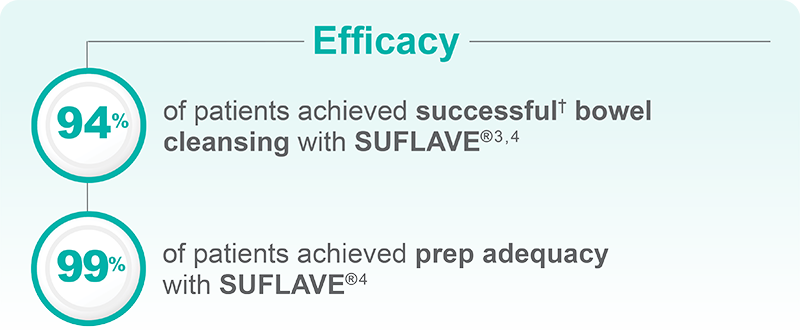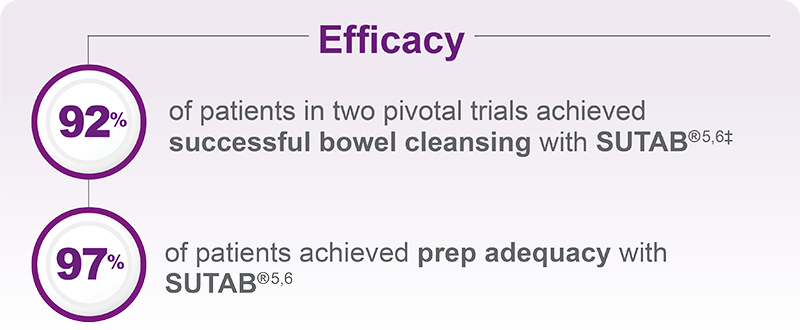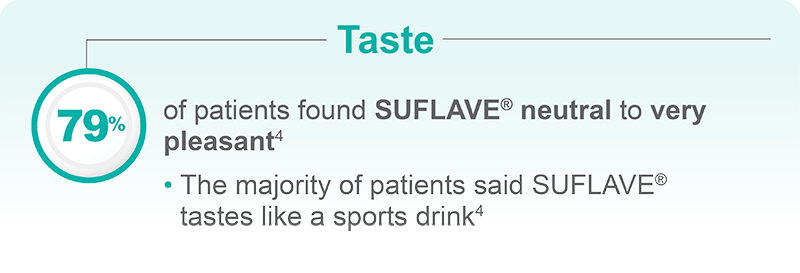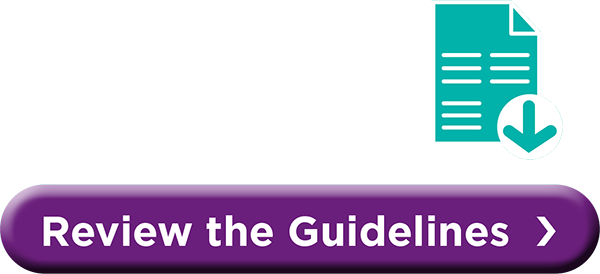






P<0.01 in this non-inferiority trial.
SUFLAVE® (polyethylene glycol 3350, sodium sulfate, potassium chloride, magnesium sulfate, and sodium chloride for oral solution) is an osmotic laxative indicated for cleansing of the colon in preparation for colonoscopy in adults.
DOSAGE AND ADMINISTRATIONA low residue breakfast may be consumed on the day before colonoscopy, followed by clear liquids up to 2 hours prior to colonoscopy. Administration of two doses of SUFLAVE® are required for a complete preparation for colonoscopy. Each bottle must be reconstituted with water before ingestion. Each bottle and one flavor enhancing packet are equivalent to one dose. An additional 16 ounces of water must be consumed after each dose. Stop consumption of all fluids at least 2 hours before the colonoscopy.
CONTRAINDICATIONSUse is contraindicated in the following conditions: gastrointestinal obstruction or ileus, bowel perforation, toxic colitis or toxic megacolon, gastric retention, hypersensitivity to any ingredient in SUFLAVE®.
WARNINGS AND PRECAUTIONSRisk of fluid and electrolyte abnormalities: Encourage adequate hydration, assess concurrent medications and consider laboratory assessments prior to and after each use; Cardiac arrhythmias: Consider pre-dose and post-colonoscopy ECGs in patients at increased risk; Seizures: Use caution in patients with a history of seizures and patients at increased risk of seizures, including medications that lower the seizure threshold; Colonic mucosal ulcerations: Consider potential for mucosal ulcerations when interpreting colonoscopy findings in patients with known or suspected inflammatory bowel disease; Patients with renal impairment or taking concomitant medications that affect renal function: Use caution, ensure adequate hydration and consider laboratory testing; Suspected GI obstruction or perforation: Rule out the diagnosis before administration; Patients at risk for aspiration: Observe during administration; Hypersensitivity reactions, including anaphylaxis: Inform patients to seek immediate medical care if symptoms occur.
ADVERSE REACTIONSMost common adverse reactions (≥2%) are: nausea, abdominal distension, vomiting, abdominal pain, and headache.
DRUG INTERACTIONSDrugs that increase risk of fluid and electrolyte imbalance.
INDICATION
SUTAB® (sodium sulfate, magnesium sulfate, potassium chloride) tablets
for oral use is an osmotic laxative indicated for cleansing of the colon in
preparation for colonoscopy in adults.
DOSAGE AND ADMINISTRATION
A low residue breakfast may be consumed. After breakfast, only clear liquids
may be consumed until after the colonoscopy. Administration of two doses of
SUTAB® (24 tablets) are required for a complete preparation for colonoscopy.
Twelve (12) tablets are equivalent to one dose. Each SUTAB® bottle contains a
desiccant. Remove and discard the desiccant from both bottles the evening
prior to the colonoscopy. Water must be consumed with each dose of SUTAB®
and additional water must be consumed after each dose. Complete all SUTAB®
tablets and required water at least 2 hours before colonoscopy.
CONTRAINDICATIONS
Use is contraindicated in the following conditions: gastrointestinal obstruction
or ileus, bowel perforation, toxic colitis or toxic megacolon, gastric retention,
hypersensitivity to any ingredient in SUTAB®.
WARNINGS AND PRECAUTIONS
Risk of fluid and electrolyte abnormalities: Encourage adequate hydration,
assess concurrent medications and consider laboratory assessments prior
to and after each use; Cardiac arrhythmias: Consider pre-dose and post-colonoscopy
ECGs in patients at increased risk; Seizures: Use caution in
patients with a history of seizures and patients at increased risk of seizures,
including medications that lower the seizure threshold; Patients with renal
impairment or taking concomitant medications that affect renal function:
Use caution, ensure adequate hydration and consider laboratory testing;
Colonic mucosal ulcerations: Consider potential for mucosal ulcerations
when interpreting colonoscopy findings in patients with known or suspected
inflammatory bowel disease. Suspected GI obstruction or perforation: Rule
out the diagnosis before administration. Hypersensitivity reactions, including
anaphylaxis: Inform patients to seek immediate medical care if symptoms
occur. Risk of Gastrointestinal Complications with Ingestion of Desiccant:
Postmarketing reports of ingestion of the desiccant along with SUTAB®
tablets has been reported and may be associated with risk of gastrointestinal
complications and/or choking.
ADVERSE REACTIONS
Most common gastrointestinal adverse reactions are: nausea, abdominal
distension, vomiting, and upper abdominal pain.
DRUG INTERACTIONS
Drugs that increase risk of fluid and electrolyte imbalance.
References: 1. Rex DK, Anderson JC, Butterfly LF, et al. Quality indicators for colonoscopy. Gastrointest Endosc. 2024;100(3):352-381. doi:10.1016/j.gie.2024.04.2905 2. Johnson DA, Barkun AN, Cohen LB, et al. Optimizing bowel preparation quality for colonoscopy: consensus recommendations by the US Multi-Society Task Force on Colorectal Cancer. Am J Gastroenterol. 2025;00:1-27. doi.org/10.14309/ajg.0000000000003287 3. SUFLAVE® [package insert]. Braintree, MA: Braintree Laboratories, Inc. 4. Bhandari R, Goldstein M, Mishkin DS, et al. Comparison of a novel, flavor-optimized, polyethylene glycol and sulfate bowel preparation with oral sulfate solution in adults undergoing colonoscopy. J Clin Gastroenterol. 2023;57(9):920-927. doi:10.1097/MCG.0000000000001894 5. SUTAB® [package insert]. Braintree, MA: Braintree Laboratories, Inc. 6. Di Palma JA, Bhandari R, Cleveland M, et al. A safety and efficacy comparison of a new sulfate-based tablet bowel preparation versus a PEG and ascorbate comparator in adult subjects undergoing colonoscopy. Am J Gastroenterol. 2021;116(2):319-328. doi:10.14309/ajg.0000000000001020 7. Vemulapalli KC, Lahr RE, Rex DK. 2021 patient perceptions regarding colonoscopy experience. J Clin Gastroenterol. 2023;57(4):400-403. doi:10.1097/MCG.0000000000001689 8. Calderwood MS, Rex DK, Halberg, et al. S488 Bowel preparation hesitancy identified as biggest barrier to screening colonoscopy: results from a large online survey of patients who complete colonoscopy. Am J Gastroenterol. 2024;119(10S): S341-S342. doi:10.14309/01.ajg.0001031320.73104.3b 9. Elwyn G, Frosch D, Thomson R, et al. Shared decision making: a model for clinical practice. J Gen Intern Med. 2012;27:1361-1367. Accessed March 24, 2025. https://doi.org/10.1007/s11606-012-2077-6 10. Agency for Healthcare Research and Quality. The CAHPS Ambulatory Care Improvement Guide: Strategy 6I: Shared Decision Making. Rockville, MD (2017). Accessed March 24, 2025. https://www.ahrq.gov/sites/default/files/wysiwyg/cahps/quality-improvement/improvement-guide/6-strategies-for-improving/communication/cahps-strategy-section-6-i.pdf 11. Rex DK, Anderson JC, Butterfly LF, et al. Quality indicators for colonoscopy. Gastrointest Endosc. 2024;100(3):352-381. doi:10.1016/j.gie.2024.04.2905 12. Wiener G, Winkle P, McGowan JD, et al. A phase 2 evaluation of a new flavored PEG and sulfate solution compared to an over-the-counter laxative, PEG and sports drink bowel preparation combination. BMC Gastroenterol. 2023;23:433. doi:10.1186/s12876-023-03069-8 13. Walker ML, Cleveland MV, Hague KM, et al. A formulation development study of BLI4900, a novel flavor enhanced bowel preparation for colonoscopy. Gastro Endoscopy. 2022;95(6, suppl). Available at https://doi.org/10.1016/j.gie.2022.04.188. Accessed Nov 11, 2024. 14. Solonowicz O, Stier M, Kim K, et al. Digital navigation improves no-show rates and bowel preparation quality for patients undergoing colonoscopy: a randomized controlled quality improvement study. J Clin Gastroenterol. 2022;56(2):166-172. doi:10.1097/MCG.





